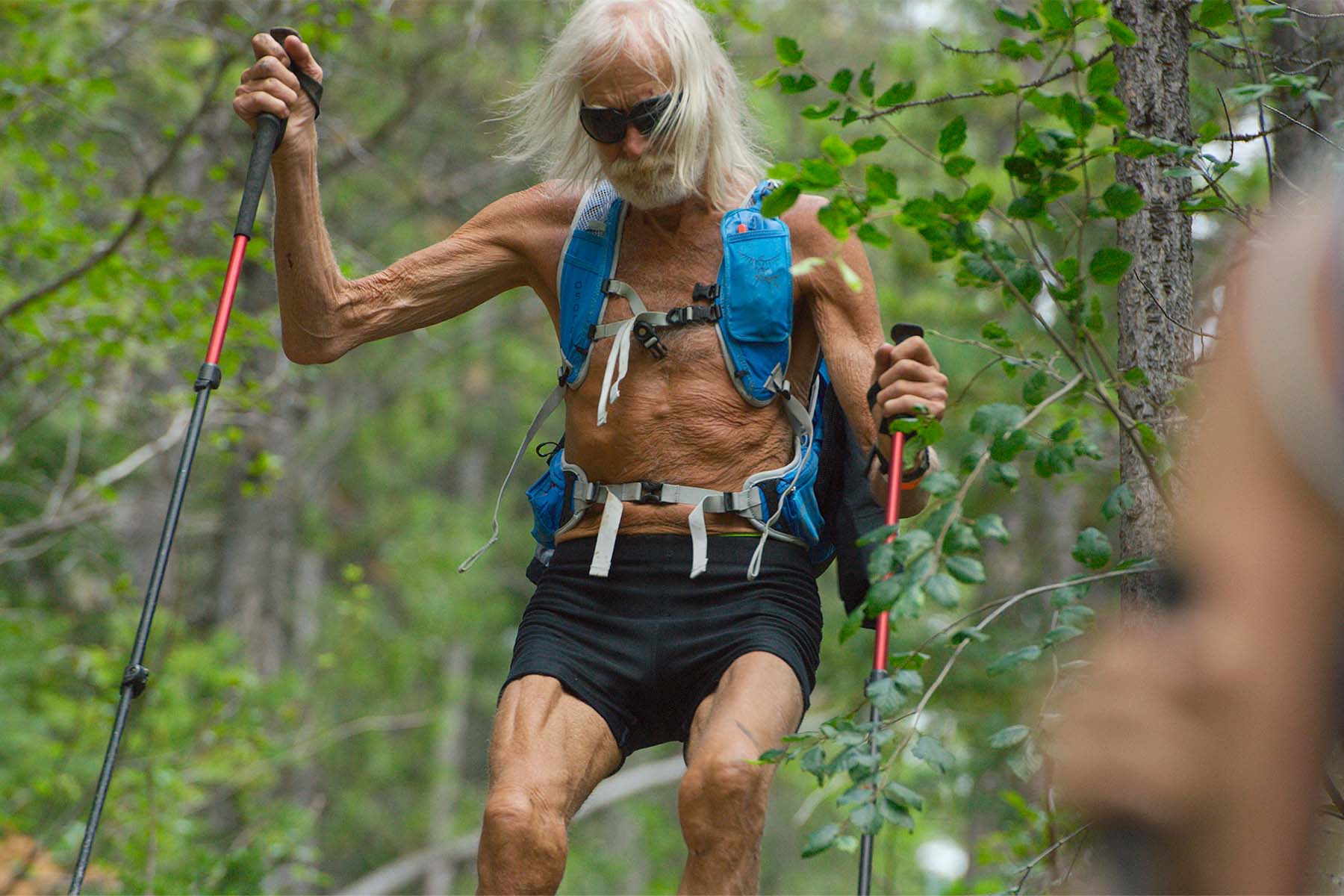Time stalks everyone, but when it catches up with a professional athlete, it can be brutal to watch. It’s why so many of the greatest names in sport often fade from the spotlight once they leave the field, to age out of sight. And it’s why, as the clock ticked down toward 8 a.m. on July 31, 2016, I stood at the start line of the Canadian Death Race, willing the oldest contestant to do what few believed possible.
For fifteen years, Dag Aabye had been coming to Grande Cache, Alberta, to push his body further and faster than many of his fellow competitors, the majority of them less than half his age. Many who started the race never finished, and those who did often took up to twenty-four hours to push and drag their bodies around the 125-kilometre mud-sloped inclines and exhausting switchbacks that make up the Death Race. Dag had completed it a record seven times, each time as its oldest competitor. But now, seven long years had passed since he last crossed the finish line. And though he was markedly slower at seventy-five than he had been at sixty-nine, he refused to give up. When he ran, he did so for sport, for pleasure, and for his own survival.
But there was something fleeting to it all. A general understanding that if he ever stopped running, he would stop existing altogether. As one of his fellow contestants noted, Dag seemed to have “an ephemeral, monk-like presence” on the trail. His slow yet relentless style appeared almost spiritual and evoked comparisons to the legendary Japanese monks of Mount Hiei who run-walk 1,000 marathons in 1,000 days in order to attain enlightenment. But he also evoked comparisons to a freak of nature: a veritable wolverine who, like the tortured mutant from the X-Men comic books, seemed to age slower than anyone else and had a capacity to withstand inhuman degrees of pain and keep pushing forward.
At any given time, he looked the part both of a battle-hardened warrior and a sage, old mystic. It was the latter image that tended to endear him to most people. Especially when he slowed his pace, approaching a fellow runner who was keeled over in pain and on the brink of collapse. He would appear to them like some half-naked septuagenarian messiah, his figure distorted through their sweat-blurred vision as he planted his feet next to theirs, placed his hand on their shoulder, and imparted some ancient-sounding wisdom.
One racer would later recall Dag’s words like so: “Look down. It does not matter where your feet were yesterday or where they are going to be tomorrow. It matters where your feet are at this moment.”
Dag never liked to start a race from anywhere but the very back of the herd. It allowed him to slip into his own meditative rhythm. He stood back from the start line and breathed in the optimism of the first-time competitors while filtering out the sound of the beats pumping out of the loudspeakers nearby. He preferred to listen to the beat of his own heart when he ran. It was the inner metronome he kept pace to. Two beats to every step—three if he was going uphill. There was a synchronization between heart and mind when he really got moving, when he swore he could feel his pulse inside his brain. That’s when the endorphins would kick in, creating a runner’s high that he called his “gateway to clarity.” Once he passed through that gateway, he could hold his pace for several hours.
Dag knew his body couldn’t move like it used to, but he was determined to push it as hard as he could for as long as possible. It didn’t bother him that he was losing momentum. He knew that ultimately his days as a Death Racer would end, not because he couldn’t handle the race but because his body would slow to such a pace that he would fail to reach the first checkpoint before the cut-off time. The prospect that someday he would be told that he was essentially too old and too slow to even start the race didn’t bother him either. Because that day still seemed distant.
Soon a rush of the youngest, most competitive runners pushed over the start line. None knew what lay before them, that by nightfall some runners in a hypothermic state would be rescued while others would be treated for exhaustion.
Dag watched the first few hundred racers disappear into the forest, heading along a mud-soaked trail that would lead them 19 kilometres toward an abandoned rail line and onward to the base of an 1,800-metre mountain. The herd was thinning out, the race already several minutes old, when he finally pressed his finger to his stopwatch and began to move. He was all alone as he crossed the start line, an elderly man who had already fallen behind the pack. He was last, but he was just getting started.
It was curiosity and desire, not ego, that drove Dag back to the Death Race again and again. Despite his advancing years, his best finish had not been his first but rather his third, when, at the age of sixty-four, he crossed the finish line after 20 hours and 56 minutes—1 minute and 54 seconds faster than he had run at the age of sixty-two. What he craved above all was the magical feeling he experienced most often on the trails near the school bus in which he lived on the side of a mountain in British Columbia, when he would reach a marker in the bush and check his stopwatch, only to surprise himself that he was running faster than he had in several years. He lived for those moments, rare as they were now, because it was then that he felt a connection to something preternatural. “It’s like touching the fountain of youth,” Dag had told me. “Juan Ponce de León went looking in the wrong place. He didn’t need to sail to Florida. All he needed was a stopwatch, a journal, and a pair of running shoes.”
There were inherent risks associated with running such a long distance, but no one went into the Death Race expecting to die. And yet, like any ultramarathon, the race had a way of making you feel as though you were pushing toward death. Much of that came from the reality that running such distances demanded much more than the expected wear on the joints, muscles, and ligaments. It disrupted multiple parts of the body’s internal function, the most common being the diversion of blood from the racers’ stomachs into their muscles, stopping their digestion and causing uncontrolled nausea. Sometimes a racer would double over with stomach pain or turn their head sideways and vomit over their shoulder while they ran. Some experienced a temporary loss of vision as their corneas swelled from a buildup of fluid. Then there were those who would end up so fatigued on the trail that they would begin to hallucinate. They were the ones who could prove a danger to themselves, seeing and hearing things along the trail that weren’t really there and, in the most problematic cases, wandering into the wilderness and getting lost.
Most elite runners reach their peak between age thirty and thirty-five. Then muscle mass, bone density, and maximal aerobic capacity begin to decrease. And though some runners do manage to run faster at fifty than they did at thirty-five, it is generally because they performed below their capacity when they were younger. Athletes running at their peak will experience a gradual trail-off from age thirty-five, and by fifty, they will have lost roughly 2 minutes and 45 seconds per year over the course of a 42.2-kilometre marathon. After age sixty, the performance declines become more drastic as the human stride shortens and ankle power decreases.
For all Dag knew, his capacity as an ultramarathon runner had probably peaked in the early 1970s, when he was in his early thirties. But he had only just begun running at that time and had confined himself to simple marathons while also living the life of a professional skier in winter and working as a full-time logger during the summers. He ran his first marathon in northern Washington in his early thirties—in a pair of jeans and without training. He finished in just under four hours, which put him in the range of intermediate runners in his age group. He competed in ten more marathons before he was fifty. In his late forties, his finishing times were hovering around 3 hours and 20 minutes. He was fast enough to qualify for the Boston Marathon, but he never bothered to enter. By his late fifties, he had also taken up competitive cross-country skiing, and by the time he turned sixty-one, he was a Canadian championship ski racer, placing fourth in his age group at the 2002 Masters World Cup cross-country ski race in Quebec despite never having had a coach.
Then someone slapped a promotional flier for the Death Race onto a table while he was eating and said, “Here’s something you’re probably too old to do.”
Dag was sixty-two when he hitched a ride to Grande Cache and entered his first Death Race. He finished in a gruelling 20 hours, 58 minutes, and 16 seconds. The next year, he crossed the finish line in 23 hours and 48 seconds. Then he came back again twelve months later, at the age of sixty-four, and posted his personal best—20 hours and 56 minutes. He ran an average of 6 kilometres an hour during that year’s race, covering roughly 560 metres more each hour than he had the year before. He used that personal best as the benchmark to track his aging and his decline up until 2009, when he finished the race for the last time, in 23 hours, 5 minutes, and 26 seconds, his pace having dropped back to roughly the same as it was when he was five years younger. It was the last time he was able to complete the entire 125-kilometre circuit in the requisite twenty-four hours.
But he never stopped trying, and every subsequent year that he fell short of the 125-kilometre mark, he succeeded in finishing what race organizers called the Near Death Marathon, a 49-kilometre ultra that was itself 7.8 kilometres longer than a regulation marathon. The Near Death Marathon, which was essentially the first half of the Death Race, had its own designated cut-off time—9.5 hours—meant to safeguard both the competitive nature of the contest and the health of its contestants. In 2010, Dag had completed the Near Death Marathon with 45 minutes to spare and used that feat as the new barometer by which to challenge his body as he entered his seventies. In 2011, he actually got faster, shedding 28 minutes from his time the previous year.
Though Dag was always the oldest person on the trail, he was inspired by runners even older than him who continued to compete in more traditional marathons around the world. Among them was the Sikh road runner Fauja Singh, who in 2011, at the age of 100, became the first centenarian to complete an organized marathon when he finished the Toronto Waterfront Marathon. Dag had read about Singh in the Globe and Mail, cut out the article, and taped it into one of his journals for inspiration. Singh was born in British India in 1911 and was so malnourished as a boy that he did not walk until the age of five. He lived through Partition and the birth of modern India and was already beyond his life expectancy when, in the mid-1990s, he took up running as a means of therapy after the deaths of his wife, a son, and a daughter. He competed in his first organized marathon at eighty-nine and set his personal best aged ninety-two, when he completed the Flora London Marathon in 6 hours and 54 minutes.
Singh, who attributed his physical longevity to abstaining from smoking and alcohol and to a vegetarian diet, lived on the outskirts of London, England, trained primarily on asphalt, and subsisted on a simple diet of phulka, dal, green vegetables, yogurt, and milk. Compared to Dag, Singh treated his body like a temple. “I take lots of water and tea with ginger,” he told a reporter with the Indian Express in 2004. “I go to bed early taking the name of my Rabba [God] as I don’t want all those negative thoughts crossing my mind.” Like Dag, Singh started every day with a long-distance run and, like in Dag’s case, the act itself was almost spiritual. “The first 20 miles are not difficult,” Singh said of his experiences as a marathon runner. “As for the last six miles, I run while talking to God.”
Dag didn’t speak to God as he ran, but he did speak of a more personal transcendence, which he struggled to describe other than to say that it was when he was nearing exhaustion that he felt closest to his own mortality. “I have to push to my limitations in order to accept my limitations,” he said.
Dag viewed age as a “state of mind” rather than an actual figure. He had read articles—which he also cut out and taped into his journals—about scientific studies that found age-related deterioration to be the side effect of a sedentary lifestyle rather than of aging. He lived by the belief that he could modulate his decline through increased training. And so he ran like few others on the planet and nobody else his age. He had worn out an average of two and a half pairs of running shoes each year ever since 1978, when he started recording such things. It’s how he knew that the Hokas on his feet were the eighty-fifth pair he had bought.
Though he accepted that he was moving slower, Dag tried to maintain the total distance he ran each year by simply increasing the hours he spent training. Where once he could routinely run 10 kilometres in under 40 minutes, it now took him over an hour. He once read that the average human walks roughly 2,200 kilometres a year, a pace that would take them roughly eighteen years to circumnavigate the globe. By contrast, Dag ran about 8,000 kilometres a year. He had reflected on that math, drawn up some calculations, and realized that, despite his age, he was running the equivalent of the entire equator once every five years. He had the logbooks to prove it.
Incredibly, by my calculations, he may have run enough miles during his lifetime to cover the distance between Earth and the moon. Dag shook his head in bewilderment when I told him how far I believed he had travelled. Then he smiled and paraphrased a quote from his childhood hero, Fridtjof Nansen, the Norwegian explorer who led the first crossing of Greenland on skis: “If it’s difficult, I’ll do it right away. If it’s impossible, it will take a little longer.”
It was 5:26 p.m.—9 hours and 26 minutes since the start of the race. Dag was well out of sight, having just run through a cemetery as storm clouds thickened overhead. The skin on his bare legs contracted against the cold as he propelled himself through the cemetery and back into town. His shoes were wearing out, his toes bleeding through his wool socks. He could feel the dampness of his blood cooling against his feet as he planted each step into the gravel on the only route back into Grande Cache.
More and more competitors were now abandoning the race as the temperature dropped toward zero. A race steward’s radio crackled at the nursing station. “We’ve got heavy winds at the top of Hamell,” the voice said. Mount Hamell was the next major peak in Dag’s path—a 2,100-metre mountain, the highest summit on the Death Race—a stunning strata with a swooping lookout that offered no protection from the elements. The route near the top of the mountain was devoid of much vegetation longer than grass. Then another voice came over the radio. It said that organizers were preparing to retrieve runners breaking down on the mountainside.
A crash of thunder echoed through the valley. A skeletal figure could be seen cresting the horizon. His pace was steady but slow—the same as it had been seven hours earlier when I watched him run along an abandoned railway track. His feet chugged along the pavement, and he was humming again—“As Time Goes By.”
The race clock registered 9:29:31 when Dag crossed the 49-kilometre checkpoint. He had reached the cut-off with 29 seconds to spare. Someone offered him water. He took a sip, handed back the paper cup, stood with his hands on his waist, and looked at the storm over Hamell. It was another 21 kilometres to reach the next checkpoint. I knew, and he knew, as did the stewards watching him, that if he carried on with the race, he was destined to get disqualified at the next cut-off. He looked back to the nursing station.
“I guess this is far enough for one day,” he said.
He raised his arms, filled his lungs with the cold air, looked at his time on the race clock, and shook his head. It was the worst time he had ever recorded.
“Look at that,” he said. “A new record to break.”
Excerpted and adapted with permission from Outsider: An Old Man, a Mountain and the Search for a Hidden Past written by Brett Popplewell and published by HarperCollins.





